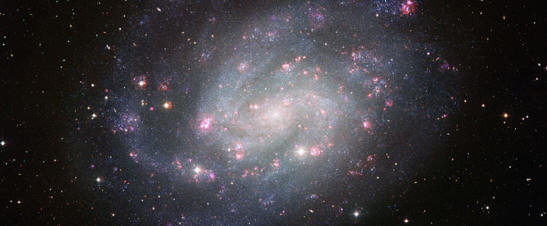|

Spiral galaxy NGC 300. Credit:
European Southern Observatory
The Light at the End
Sep
10, 2010
This image of the nearby galaxy NGC
300 covers an area of the sky about
the size of the full moon.
Astronomers call it a “wide field,”
which shows how much modern
astronomy is afflicted with tunnel
vision.
A wider view would see a line of
quasars stretching nine degrees to
the Southeast. A cloud of hydrogen
gas lies nearby but is rotated about
20 degrees with respect to the
galaxy’s core. (It’s called hydrogen
gas because of the radio emission
that reveals it, but its filamentary
form and synchrotron radiation
indicate that it’s actually a
Birkeland current of plasma.)
NGC 300 and its companion, NGC
55, a short distance away, are the
dominant members of the Sculptor
Group, the nearest cluster of
galaxies to our Local Group. As is
typical for such groups, the
dominant members have the lowest
redshifts. All the other smaller
galaxies in the group have
consistently higher redshifts. The
standard Doppler interpretation of
redshift would have all clusters
elongated and pointing at the Earth.
This observation alone requires
that redshift of galaxies be
primarily intrinsic, not Doppler.
The only way to adhere to a Doppler
interpretation (and with it an
expanding universe interpretation,
and the Big Bang theory following on
a short leash) is to restrict one’s
vision to a tunnel that encompasses
only one galaxy at a time.
The Sculptor Group is embedded in
a cloud of quasars that is up to ten
times denser than the average
cosmological background density. In
fact, most of the excess quasars
cluster around the two dominant
galaxies—NGC 300 and NGC 55.
Halton Arp tells the story of
this early inadvertent finding in
his book
Quasars, Redshifts, and
Controversies:
"Now an extraordinary stroke of
good luck occurred when two
astronomers at the U.S. National
Observatory in Chile, decided to
observe a sample of quasars. They
picked a declination zone that ran
high overhead for them (Dec = -40°)
and observed a long, narrow strip of
sky, 5 degrees wide, running from
west to east. The good luck was that
this strip runs right across our
Sculptor galaxies NGC 300 and NGC
55. The beginning and the end of the
strip lie outside the Sculptor group
and can be used to compare to the
results in the center of the strip.
"An uncomfortable result became
apparent as soon as they plotted
their results. A good many more
quasars were found in the center of
the strip than at the edges. Since
these two astronomers accepted
unquestioningly that the quasars
were out at the far reaches of the
universe, this result obviously
could not be correct. Therefore,
after the fact, they decided that
the photographic emulsions they had
used were less sensitive on either
end of the strip than they were in
the middle of the strip!
"This was duly published and
accepted. But I noticed that the
quasars at the ends of the strip
contained proportionally more
'weak-lined' quasars. That is, the
emission lines identifying them as
quasars were fainter and they were
consequently more difficult to
discover. If the photographic
emulsions were really less sensitive
at the ends of the strip, then a
proportionally smaller number of
these quasars should have been found
rather than a larger number. When I
tried to publish this result in the
British journal, Monthly Notices of
the Royal Astronomical Society, it
was sent to one of the original two
authors to referee. Needless to say,
it was not published."
In the beginning of telescopes in
space, astronomers decided not to
put up a wide field instrument that
would survey what there was to see
from orbit: They assumed that they
already knew what there was to see.
So they put up the Hubble with its
extremely narrow field in order to
confirm the details of what they had
deduced from first principles (i.e.,
from their presumptions).
Everything since has been a
surprise. Now, finally, they’re
making instruments with slightly
less narrow views. But their
eyes—their minds’ eyes—have been
conditioned to see only down the
conceptual tunnel. “The main
purpose of this extensive
observational campaign was to take
an unusually thorough census of the
stars in the galaxy…that warrant
deeper and more focused
investigation.” Perhaps the
continual surprises will eventually
lead them out of the tunnel.
At the end of the tunnel, vision
opens onto a panorama of plasma:
everything we observe is connected
with webs of genealogy traced in
lines of quasars, clusters of
galaxies, hydrogen filaments, and
x-ray emissions. The cosmos is not
an ancient convulsion followed by
predictable inertial drifting. It
has a history. It’s a drama of
procreation unto the present day.
Irving Langmuir named plasma
well—because it seems alive. The
cosmos seems alive—a “live wire”!—as
plasma discharges, coupled across
all scales, move an aboriginal
charge separation toward a likely
never-attainable equilibrium. We
live in the midst of Heraclitus’s
“thunderbolt that steers the
universe.”
Mel Acheson
|







